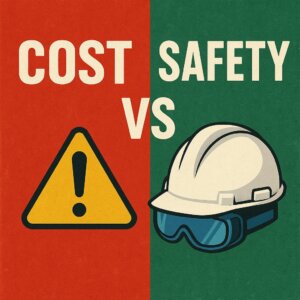If you work in industries like construction, manufacturing, or glass handling, EN 388-certified gloves are your frontline defense against mechanical hazards. This European standard ensures gloves meet rigorous safety benchmarks. In this guide, we’ll decode EN 388 testing, ratings, and how to choose the right gloves for your needs.
What Is EN 388?
EN 388 is the European standard for mechanical risk protection in gloves, governed by the European Committee for Standardization (CEN). The latest revision, EN 388:2016+A1:2018, introduced critical updates to improve accuracy in cut resistance and abrasion testing
Key facts:
- Applies to gloves exposed to abrasion, cuts, tears, punctures, and impacts.
- Mandatory for PPE sold in the EU and widely adopted globally.
- Replaced the 2003 version to address limitations in testing high-tech materials like steel fiber blends
EN 388 Testing Methods & Performance Levels
The standard evaluates gloves through 5 mechanical tests, with results displayed in a 6-character code (e.g., 4X43F P).
1. Abrasion Resistance
- Test: Rotate 180-grit sandpaper under 9 kPa pressure until the material tears.
- Levels: 1–4 (Level 4 = survives ≥8,000 cycles)
2. Cut Resistance (Coup Test & TDM-100)
- Coup Test: Measures circular blade rotations needed to cut through material (Levels 1–5).
- TDM-100 Test: Uses a straight blade under increasing force (Levels A–F).
- Why two tests? High-hardness materials (e.g., glass fibers) can dull blades, making Coup Test unreliable. If blade dulling occurs, TDM-100 results replace Coup scores (marked as “X”)
3. Tear Resistance
- Test: Force required to tear material apart.
- Levels: 1–4 (Level 4 = ≥75 Newtons)
4. Puncture Resistance
- Test: Force needed to pierce material with a steel spike.
- Levels: 1–4 (Level 4 = ≥150 Newtons)
5. Impact Protection (Optional)
- Marking: “P” indicates gloves reduce impact force to ≤7 kN. No “P” = untested .
How to Read EN 388 Labels
A sample label 4X43F P breaks down as:
- 4 – Abrasion resistance (Level 4)
- X – Coup Test invalid; TDM-100 used
- 4 – Tear resistance (Level 4)
- 3 – Puncture resistance (Level 3)
- F – TDM-100 cut rating (highest level)
- P – Passed impact protection test
Note: A “0” means the glove failed Level 1. If any test fails Level 1/A, the EN 388 logo is removed
Key Updates in EN 388:2016 vs. Older Versions
- Abrasion test refinement: 180-grit sandpaper replaces 100-grit for realistic wear simulation
- TDM-100 cut test: Mandatory for materials that dull blades, ensuring accurate ratings for advanced fibers
- Impact protection: Added optional testing for heavy machinery/construction gloves .
EN 388 vs. ANSI/ISEA 105: Key Differences
While both standards evaluate cut resistance, they’re not directly comparable:
| Factor | EN 388 | ANSI/ISEA 105 |
|---|---|---|
| Cut Test Method | Coup Test (circular blade) + TDM-100 (straight blade) | TDM-100 (straight blade) |
| Cut Ratings | 1–5 (Coup) or A–F (TDM-100) | A1–A9 (grams of force) |
| Impact Testing | Optional (P/F/X) | Separate standard (ANSI/ISEA 138) |
Pro Tip: Gloves sold in North America often display both ratings (e.g., EN 388 F ≈ ANSI A6) .
Industry-Specific Recommendations
- Construction: Prioritize abrasion (Level 4) and puncture resistance (Level 3+)
- Metal/Glass Handling: Opt for TDM-100 Level E/F .
- Automotive: Combine tear resistance (Level 4) with impact protection (“P”) .
FAQs
Q: How often should I replace EN 388-certified gloves?
A: Replace every 3–6 months, even if undamaged. Abrasion and UV exposure degrade materials over time
Q: Are EN 388 gloves chemical-resistant?
A: No. For chemical hazards, pair with EN ISO 374-certified gloves.
Q: How to verify compliance?
A: Check for the EN 388 logo, 6-character code, and CE mark. Request third-party test reports from suppliers








